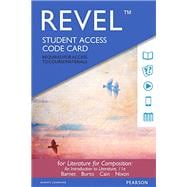With an emphasis on critical thinking and argument, REVEL for Literature for Composition offers superior coverage of reading, writing, and arguing about literature enhanced by an array of multimedia interactives that prompt student engagement. Throughout REVEL’s flexible online environment, the authors demonstrate that the skills emphasized in their discussions of communication are relevant not only to literature courses, but to all courses in which students analyze texts or write arguments.
REVEL™ is Pearson’s newest way of delivering our respected content. Fully digital and highly engaging, REVEL gives students everything they need for the course. Informed by extensive research on how people read, think, and learn, REVEL is an interactive learning environment that enables students to read, practice, and study in one continuous experience–for less than the cost of a traditional textbook.
NOTE: REVEL is a fully digital delivery of Pearson content. This ISBN is for the standalone REVEL access card. In addition to this access card, you will need a course invite link, provided by your instructor, to register for and use REVEL.












